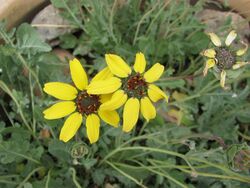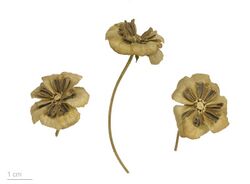Biology:Berlandiera lyrata
| Berlandiera lyrata | |
|---|---|

| |
| Scientific classification | |
| Kingdom: | Plantae |
| Clade: | Tracheophytes |
| Clade: | Angiosperms |
| Clade: | Eudicots |
| Clade: | Asterids |
| Order: | Asterales |
| Family: | Asteraceae |
| Genus: | Berlandiera |
| Species: | B. lyrata
|
| Binomial name | |
| Berlandiera lyrata Benth.
| |
| Synonyms[1] | |
|
Berlandiera incisa Torr. & A.Gray | |
Berlandiera lyrata, with the common names chocolate flower, chocolate daisy, or lyreleaf greeneyes, is a North American species of flowering plant in the family Asteraceae.[2] The common name lyreleaf greeneyes is a reference to the shape of the leaf, which is curved like a lyre and the green disc which is left behind when the ray florets drop off which is thought to look like an eye.[3]
Description

The plant grows to about 30–60 centimetres (1–2 feet) in height and width,[3] less commonly 120 cm (4 ft).[4] When the plant freezes, the roots will preserve its life.[5] The velvety leaves are pinnately lobed or scalloped.[5][4] The flower head is approximately 4 cm (1 1⁄2 inches) in diameter, with 5–12 (most commonly 8) yellow ray florets, which are 1.5 cm (5⁄8 in) long.[4] In areas that freeze, the flowers bloom at night from spring until frost.[3] In frost-free areas, it will bloom year-round (typically April to October).[3][4] Around mid-morning, the flowers close or drop.[3] As it gets hotter, the flower begins to turn white and the ray florets begin to drop, leaving the green disc shape.[5] The seed-like fruit is scaleless and hairless at the tip.[4]
Distribution and habitat
In the United States , the species is native to Colorado, Kansas , Oklahoma, Arizona, New Mexico, Texas , and Arkansas. In Mexico, it is native to Chihuahua, Coahuila, Nuevo León, San Luis Potosí, Durango, Sonora, Zacatecas, Aguascalientes and Jalisco.[6][7][8] It prefers the U.S. Department of Agriculture's hardiness zones of 4 to 9, and can be grown in elevations as high as 2,100 m (7,000 ft).[5] It can usually be found in grassy areas and rocky soil.[4]
Cultivation
B. lyrata is a hardy perennial, cultivated as an ornamental plant. It is grown in gardens for the chocolate-like scent of its flowers.[9] The chocolate odor can also be produced by plucking the ray florets from the flower head.[10] To ensure that it will continue to bloom as long as possible, spent flowers should be removed.[10]
It grows best in full sun locations. It is native to soil types that are dry, shallow and rocky such as sandy loams and limestone soils.[3] It is known to grow along roadsides and in grasslands in the southwest US.[3] It is drought-tolerant.[3] In heavy, wet soils, B. lyrata is subject to root rot.[10] B. lyrata can be planted in areas that are mowed frequently and can be mowed itself.[10]
The plant is propagated through seeds which can be collected from the plant itself and germinated outdoors from spring to fall.[10]
Uses
The flower head is known to attract beneficial insects to the garden.[9]
The stamens have a chocolate flavor and are edible.[9][10] The plant was also used by Native Americans to alleviate symptoms of stomach problems.[5] Some Native American cultures would burn the dried roots of the plant in order to treat nervous conditions or to inspire courage.[5]
References
- ↑ The Plant List, Berlandiera lyrata Benth.
- ↑ "Berlandiera lyrata". http://www.efloras.org/florataxon.aspx?flora_id=1&taxon_id=250066218. Retrieved 2007-10-04.
- ↑ 3.0 3.1 3.2 3.3 3.4 3.5 3.6 3.7 "Berlandiera lyrata". http://www.missouribotanicalgarden.org/PlantFinder/PlantFinderDetails.aspx?taxonid=242272&isprofile=0&. Retrieved 9 May 2015.
- ↑ 4.0 4.1 4.2 4.3 4.4 4.5 Spellenberg, Richard (2001). National Audubon Society Field Guide to North American Wildflowers: Western Region (rev ed.). Knopf. pp. 360. ISBN 978-0-375-40233-3. https://archive.org/details/nationalaudubons00spel/page/360/.
- ↑ 5.0 5.1 5.2 5.3 5.4 5.5 "August: Chocolate Flower: Berlandiera lyrata". August 2012. http://www.santafebotanicalgarden.org/august-2012/. Retrieved 9 May 2015.
- ↑ {{citation | mode = cs1 | title = Berlandiera lyrata | work = Germplasm Resources Information Network (GRIN) | url = | publisher = [[Organization:Agricultural Research ServAgricultural Research Service (ARS), United States Department of Agriculture (USDA) | access-date = 2007-10-04 }}
- ↑ Biota of North America Program 2014 county distribution map
- ↑ Turner, Billie Lee 1988. Phytologia 64(3): 205–208 distribution map on page 208
- ↑ 9.0 9.1 9.2 "Berlandiera lyrata: Chocolate Scented Daisy". http://www.mountainvalleygrowers.com/berlyrata.htm. Retrieved 9 May 2015.
- ↑ 10.0 10.1 10.2 10.3 10.4 10.5 "Berlandiera lyrata". Ladybird Johnson Wildflower Center. http://www.wildflower.org/plants/result.php?id_plant=BELY. Retrieved 9 May 2015.
External links
Wikidata ☰ Q503792 entry
 |


